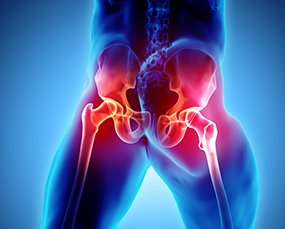Hip and pelvic pain is a common issue affecting millions around the globe. Whether it’s caused by a simple muscle strain or something more complex like a pelvic fracture, the discomfort can range from a mild annoyance to a debilitating challenge. Understanding the causes, symptoms, and various treatment options for hip and pelvic pain is crucial for those suffering from this condition. In this comprehensive guide, we will delve into the complexities of hip and pelvic pain, aiming to provide valuable insights and practical solutions to alleviate discomfort.
Contents
Can Hip Pain Be Related To Pelvic Pain?
 Certainly! Hip and pelvic pain can be closely related. And often one may lead to or exacerbate the other.
Certainly! Hip and pelvic pain can be closely related. And often one may lead to or exacerbate the other.
In the first instance, the hip and pelvic regions are anatomically interconnected, sharing muscles, ligaments, and nerves. Pain or dysfunction in the hip can create imbalance or tension in these shared structures. That may translate into pain or discomfort in the pelvic area. For example, conditions like hip osteoarthritis or a hip muscle strain can alter the normal movement and alignment of the hip. Thereby affecting the pelvis and causing pain or stiffness in that region as well.
Secondly, the underlying causes of both hip and pelvic pain may be similar or even the same. For instance, a problem in the hip joint may be felt in the pelvic region or vice versa. The close relationship between the hip and pelvis requires a comprehensive approach to diagnosis and treatment. This connection emphasizes the importance of holistic care and consideration of both the hip and pelvic regions when addressing pain or dysfunction.
Why Do My Hips And Pelvic Area Hurt?
Here is some general information about potential causes. That may help you understand why you might be experiencing discomfort. But for a more accurate diagnosis, you must consult a professional.
- Muscular Strain or Overuse
Engaging in strenuous activities or sports that require repetitive hip movements might strain the muscles, tendons, and ligaments surrounding the hip and pelvis. Prolonged sitting or standing in an improper position can also contribute to overuse injuries.
- Inflammatory Conditions
Conditions like arthritis can cause inflammation within the hip joint or surrounding tissues. Eventually, leading to stiffness and pain. Bursitis, which is inflammation of the bursae (small fluid-filled sacs), can also cause localized discomfort.
- Injury or Trauma
Falls, car accidents, or sports-related injuries can lead to fractures, dislocations, or soft tissue injuries in the hip and pelvic region. Depending on the severity, treatments can range from rest and immobilization to surgical intervention.
- Nerve Compression or Irritation
Sciatica, caused by compression or irritation of the sciatic nerve, can create a sharp, shooting pain that travels from the lower back to the hip and down the leg.
- Alignment or Postural Issues
Imbalances in your body’s alignment can lead to biomechanical stress, affecting both the hip and pelvic area. Physical therapy often focuses on strengthening and stretching exercises to correct these imbalances and alleviate pain.
- Pregnancy and Childbirth
During pregnancy, hormonal changes and increased weight can place extra stress on the hip and pelvic region. After childbirth, physical changes in the pelvis can also cause discomfort. Specialized physical therapy may be beneficial in these cases.
- Underlying Medical Conditions
Some medical conditions such as endometriosis, urinary tract infections, or gastrointestinal disorders might cause symptoms in the hip and pelvic region. Accurate diagnosis and targeted treatment are crucial for relief in these cases.
- Chronic Conditions
Degenerative conditions like osteoarthritis gradually wear down the cartilage in the hip joint, causing pain and limited mobility. Treatments might include lifestyle changes, physical therapy, medication, or possibly joint replacement surgery.
- Referred Pain
Pain felt in the hip or pelvis may actually originate from another part of the body, such as the lower back. This phenomenon requires careful diagnosis to determine the root cause and appropriate treatment.
Consulting with healthcare providers specializing in orthopedics, physical therapy, or other relevant fields will likely provide the most accurate diagnosis. And also, an effective treatment plan for your specific situation.
When Should I Be Concerned About Hip And Pelvic Pain?
 Hip and pelvic pain can range from mild and transient to severe and chronic. While mild pain might be a result of simple overuse or strain that will resolve with rest, there are times when hip and pelvic pain can be a sign of a more serious issue.
Hip and pelvic pain can range from mild and transient to severe and chronic. While mild pain might be a result of simple overuse or strain that will resolve with rest, there are times when hip and pelvic pain can be a sign of a more serious issue.
You should be concerned and consider seeking medical attention if you experience any of the following:
- Persistent or Worsening Pain: If the pain persists for several days, worsens despite rest, or is unresponsive to over-the-counter pain relievers. Then, it may indicate a more serious underlying condition.
- Sudden or Intense Pain: Sudden, sharp, or intense pain. Especially if it occurs without any apparent cause, can be a sign of a severe injury or other acute problem that requires immediate medical attention.
- Swelling or Redness: Swelling, redness, or warmth in the hip or pelvic area could be indicative of an infection or inflammation that needs professional care.
- Limited Mobility: Difficulty in moving the hip, leg, or pelvis, or a loss of range of motion, could signal a significant issue with the muscles, bones, or joints in the area.
- Associated Symptoms: If the pain is accompanied by other concerning symptoms like fever, unexplained weight loss, changes in bowel or bladder habits, or numbness and tingling. Then, it might be part of a more complex health issue.
- Trauma or Injury: If the pain is the result of a fall, accident, or other forms of trauma, it’s vital to get a medical assessment to rule out fractures or other serious injuries.
- Pain During Pregnancy: Hip and pelvic pain during pregnancy should always be evaluated by a healthcare provider. They will ensure both the mother’s and baby’s well-being.
In general, listening to your body and being proactive about seeking medical care when something doesn’t feel right is wise. Healthcare professionals can conduct a thorough examination to pinpoint the cause of your pain and recommend the most appropriate treatment plan.
How Do You Relieve Pelvic And Hip Pain?
Relieving pelvic and hip pain can often be accomplished with a combination of exercises, stretches, and home remedies. Here are some general suggestions that might be helpful:
Exercises and Stretches
1. Hip Flexor Stretch:
- Kneel on one knee with the other foot in front.
- Push hips forward gently, feeling a stretch in the front of the hip.
- Hold for 20-30 seconds and repeat on the other side.
2. Piriformis Stretch:
- Lie on your back with your knees bent.
- Cross one ankle over the opposite knee and gently pull the uncrossed leg towards you.
- Hold for 20-30 seconds and repeat on the other side.
3. Pelvic Tilt:
- Lie on your back with your knees bent.
- Gently arch your lower back and then flatten it into the floor.
- Repeat 10-15 times.
4. Bridge Exercise:
- Lie on your back with your knees bent and feet flat on the floor.
- Lift your hips towards the ceiling, squeezing the glutes.
- Hold for a few seconds and repeat 10-15 times.
5. Cat-Cow Stretch:
- On your hands and knees, arch your back towards the ceiling (cat), then lower it towards the floor (cow).
- Repeat 10-15 times.
Home Remedies

- Heat and Cold Therapy: Applying ice can reduce inflammation, while heat can relax muscles. Alternate between the two or use whichever feels best.
- Over-the-Counter Pain Relievers: NSAIDs like ibuprofen can help with pain and inflammation. Always follow the instructions on the packaging or consult with a healthcare provider.
- Epsom Salt Baths: Soaking in a warm bath with Epsom salts can relax muscles and alleviate pain.
- Proper Ergonomics: Make sure your work and living spaces support proper posture. Sitting with feet flat and back supported can reduce strain on the hips and pelvis.
- Mindfulness and Relaxation Techniques: Stress can exacerbate pain, so techniques like deep breathing, meditation, or gentle yoga might be helpful.
These exercises and home remedies may help alleviate hip and pelvic pain. But they are general suggestions and might not be suitable for everyone or every condition. Personalized guidance from a physical therapist or other healthcare provider who is familiar with your specific situation is usually the best approach.
Conclusion
In the complex landscape of hip and pelvic pain, understanding the intricate interplay of causes, symptoms, and treatments is paramount. Whether you’re dealing with a temporary strain or a chronic condition, recognizing when to seek professional help and employing appropriate strategies can make a significant difference in your quality of life. This comprehensive guide serves as a starting point.
But it’s essential to remember that personalized care from healthcare providers is often the most effective path to relief. By embracing a holistic approach that encompasses prevention and awareness, you can navigate the challenges of hip and pelvic pain with confidence and support. If you’re experiencing Hip pain, physical therapy for hip pain at PhysioMantra can help: Book an online physical therapy session.



